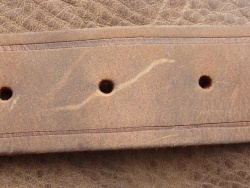Difference between revisions of "Oils & fats in the leather industry"
| Line 5: | Line 5: | ||
==Oils, fats and waxes in the [[leather production]]== | ==Oils, fats and waxes in the [[leather production]]== | ||
| − | + | The use of greases, oils and waxes in the [[leather production|leather production process]] is important. The substances are used in production to influence certain [[leather quality|properties]] ([[Haptic evaluation of leather surfaces|softness]], [[Waterproofing leather|waterproofing]] or appearance). Fats, oils and waxes are main component of [[leather care]] and are sometimes used as substance of the [[Tanning with fats and oils|tanning]] itsefe. | |
| − | + | ||
| − | + | ||
==Fatliquoring (regreasing)== | ==Fatliquoring (regreasing)== | ||
| − | In the [[leather production|tanning process]], the natural fats of the animal are removed from the [[rawhide]] as they are not preserved and become rancid. In order to obtain a [[leather quality|soft and stable]] leather, it must be re-greased. Already at the origins of tanning, leather was therefore re-greased with milk, [[brain | + | In the [[leather production|tanning process]], the natural fats of the animal are removed from the [[rawhide]] as they are not preserved and become rancid. In order to obtain a [[leather quality|soft and stable]] leather, it must be re-greased. Already at the origins of tanning, leather was therefore re-greased with milk, [[brain tanning|brain]], egg yolk, vegetable oil or fish transe (also called "fish oil"). Fats were also used for fat tanning. A finished [[Pull up leather - Greased leather - Waxed leather - Oiled leather|fat leather]] has a fat content of up to 25%. |
Fatliquoring refers to the refatting of [[leather]] with water-soluble oils. This can be done in the tanning process or even after [[Washing and dry cleaning leather|dry cleaning]]. Dry cleaning is a cleaning process in a solvent bath which strongly degreases the leather. The fatliquor makes the leather supple and stable and the "starved" look of the degreased leather gets a handsome appearance again. | Fatliquoring refers to the refatting of [[leather]] with water-soluble oils. This can be done in the tanning process or even after [[Washing and dry cleaning leather|dry cleaning]]. Dry cleaning is a cleaning process in a solvent bath which strongly degreases the leather. The fatliquor makes the leather supple and stable and the "starved" look of the degreased leather gets a handsome appearance again. | ||
| − | + | Oils and fats in leather affects the [[leather smell|smell of leather]]. It is only one substance of many substances used when [[Leather production|tanning]] which influences the smell of the finished leather. Fatliquors of good quality do not have an intrusive odor. | |
Revision as of 22:00, 23 November 2016
Contents
Oils, fats and waxes in the leather production
The use of greases, oils and waxes in the leather production process is important. The substances are used in production to influence certain properties (softness, waterproofing or appearance). Fats, oils and waxes are main component of leather care and are sometimes used as substance of the tanning itsefe.
Fatliquoring (regreasing)
In the tanning process, the natural fats of the animal are removed from the rawhide as they are not preserved and become rancid. In order to obtain a soft and stable leather, it must be re-greased. Already at the origins of tanning, leather was therefore re-greased with milk, brain, egg yolk, vegetable oil or fish transe (also called "fish oil"). Fats were also used for fat tanning. A finished fat leather has a fat content of up to 25%.
Fatliquoring refers to the refatting of leather with water-soluble oils. This can be done in the tanning process or even after dry cleaning. Dry cleaning is a cleaning process in a solvent bath which strongly degreases the leather. The fatliquor makes the leather supple and stable and the "starved" look of the degreased leather gets a handsome appearance again.
Oils and fats in leather affects the smell of leather. It is only one substance of many substances used when tanning which influences the smell of the finished leather. Fatliquors of good quality do not have an intrusive odor.
Raw materials for the fatliquoring agents
Sea animals oils: Fish oil
Land animal oils and fats: Claw oil, beef tallow, pig fat, bone fat
Vegetable oils and fats: Palm oil, sunflower oil, rapeseed oil, soybean oil, coconut fat, palm kernel fat, turkey red oil
Waxes: Carnauba wax, montan wax, wool grease
Synthetic fats: Paraffin oil, mineral oil, fatty alcohol, fatty acid ester
Fish oil - Claw oil
Fats in leather care and finish
Leather is not only greased and oiled in the production to make it supple and soft. Fats and oils are also used as leather care in order to correct wear (in particular, shoe polish), or to waterproof leather, or to preserve old and dry leather by re-greasing and softening.
Oils, greases and waxes are also used in the finish. In case of pull up (greased leather - waxed leather - oiled leather), these substances are used to achieve certain effects in the surface. Pull-up usually hase a patina optics which increases with the time.
Pull up leather - Waxed leather
Additional information
- Pull up leather - Greased leather - Waxed leather - Oiled leather
- Leather care
- Shoe care
- Tanning with fats and oils
Video about the leather production
The leather production in a modern tannery.












 a kotori web solution
a kotori web solution